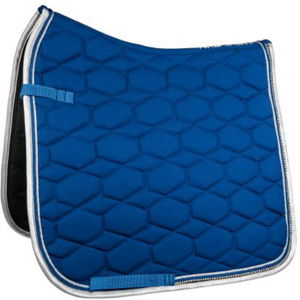Saddle Pads
(957)A high-quality saddle pad combines several purposes in one: On the one hand, it functions as a pressure-regulating and aesthetically valuable horse saddle... LEARN MORE
Frequently asked questions about Saddle Pads
A saddle pad represents an entity between the horse's back and the saddle, protecting the sensitive leather of the saddle from dirt and sweat. Available in many shapes and colours, many saddle pads are not only a fashionable accessory, but due to their certain thickness, they can also cushion movements and shocks that pass from the saddle to the horse's back.
Saddle pads quickly become dirty in daily use, as dirt and sweat get trapped in them. If the dirt has not yet advanced so far, brushing out dust and dirt with a soft brush is sufficient. If, however, washing can no longer be avoided, make sure that all Velcro fastenings are closed before washing and remove coarse, loose horse hair with a soft brush. In order to maintain the shape of the saddle pads, they should not be washed at more than 40°C. It is also advisable to spin the saddle pads as little as possible so that they can be pulled back into shape after washing. After the saddle pad has been air-dried, it can be used again in the stable.
Standard saddle pads without large or special padding, quilting or even rhinestone application are available from 30 €. Depending on the manufacturer, thickness of the material or due to special applications, the price increases gradually. Even pricier are saddle pads equipped with additional lambskin. When buying a saddle pad, you should look for good quality, because saddle pads have to withstand a lot in everyday use. In the middle price segment, you should pay around 50 € for a good basic saddle pad.
Saddle pads should be of good quality and have a high degree of form stability. The latter is important to avoid creases under the saddle. Pressure points should be avoided at all costs, which is why saddle pads that are too thick are just as unsuitable as those that are too thin. Thick saddle pads can distort the fit of the saddle and cause pressure points. Thin saddle pads, on the other hand, quickly become creased or start to slip, which again can cause pressure points. Furthermore, it is of course important to choose the right size to ensure an optimal fit.
The right size depends, among other things, on the size of the horse and the saddle, as well as the type of saddle. First and foremost, you should ask yourself what kind of saddle you have and then look for dressage saddle pads or jumping saddle pads. The difference lies in the cut of the two shapes. Dressage saddle pads are much longer and straighter, whereas jumping saddle pads are shorter and curved to fit the shape of the saddle. The second point to bear in mind is what kind of horse you are dealing with. Large horses always wear the large sizes, known as " DL " or " VS ". If it is a pony, the pony size may well be necessary, although many ponies can also wear the large sizes. The best thing to do here is to try them out.
The abbreviation "DL" stands for dressage length and is one of the many designations used to determine the size and shape of the saddle pad. If you own a dressage saddle, you should opt for a dressage saddle pad, as all other shapes disappear under the long saddle flap of a dressage saddle and thus cause pressure points. Dressage saddles, like dressage saddle pads, are longer as a whole and cut straighter at the front. Basically, DL saddle pads are designed for large horses that wear a dressage saddle.
The abbreviation "VS" refers to an eventing saddle pad. If you own an eventing saddle or a jumping saddle, you should use this type of pad. Significant differences to dressage saddle pads and saddles are not only in the shape of the saddle, but also in the cut of the saddle pads. For example, eventing saddle pads are shorter in length because the saddle flap is also cut shorter. There are also differences in the front area of the pad, as the slightly forward curved cut provides optimum protection for the jumping saddle. There is a special feature for eventing saddles with a focus on dressage. These saddles are similar to a jumping saddle but have a slightly longer saddle flap, creating the abbreviation and another shape called "VSD" (eventing dressage). For all other jumping saddles or also eventing saddles, the abbreviation "VSS" (eventing jumping) is used.
How many saddle pads you ultimately need cannot be determined, as it is an individual question. However, it should be said that for normal use, regardless of aesthetic aspects, three saddle pads are completely sufficient. Particularly in summer, sweat builds up, which means that the saddle pads have to be changed frequently. With three saddle pads, there is always one in use, one on reserve and one in the wash. This guarantees that there is always a freshly washed and dry saddle pad available.
Differences and common features of saddle rugs
Saddle pads are placed on the horse's back before the saddle is attached. Leading manufacturers use cotton, synthetic materials, velvet or felt as material. From a functional point of view, the shape plays a practical and significant role, as a distinction is made between jumping and dressage saddle pads that can be used for the respective sport.
It is not uncommon for riders to decorate saddle pads with letterings, brandings or other applications. Saddle pads therefore combine tradition, aesthetics and practical use within equestrian sports.
What are some advantages and special features of horse saddle pads?
- Quality products effectively counteract any possible formation of sweat on the horse's back. Worn properly, a saddle pad compensates for unevenness which noticeably increases the comfort of the saddled horse and the rider. This is a sensitive aspect, which is of enormous significance for leisure riders, competition riders and show participants.
- Good air permeability, high breathability, easy care and best workmanship mark the most important characteristics of high-quality offers.
- Saddle pads offer ergonomic benefits by protecting the horse from unpleasant pressure. They function as a protective layer between the saddle and the horse's back. In this way they contribute to a harmonious relationship between rider and horse.
Different types and uses
We offer optimised types of saddle pads for dressage or show jumping. Some models are equipped with straps to keep the saddle pad in place. Strap loops with Velcro fasteners also make handling easier. Take a look at our offers for show jumping, dressage or eventing.
Jumping saddle pads
In our wide range of products, we offer the necessary equestrian supplies such as stirrups for riders who compete in shows. The sporty fit of our jumping saddle pads prevents the saddle from slipping. All our models take the horse's anatomy into account and are easy to handle. Selected upper and lower material as well as stabilising inserts absorb the pressure in a sensible way. Design and shape flatter the horse so that it can deliver its best performance.
Dressage saddle pads
Dressage saddle pads are attached to the horse's back and form the foundation under the saddle. During training, the muscles of the horse receive important relaxation phases that form the basis for recovery and lasting concentration. Unlike jumping saddle pads, the material used in dressage saddle pads has a firmer character. The variants available for ambitious dressage are made of FlexiFleece without memory effect, so they always keep their shape. As you can imagine, they are quite easy to care for, as the products can be washed at 30°C.
In our online shop, quality, demand and design come together to help you find the ideal model for your four-legged friend and yourself. If you have any questions about saddle pads, please do not hesitate to contact our customer service.



















































































